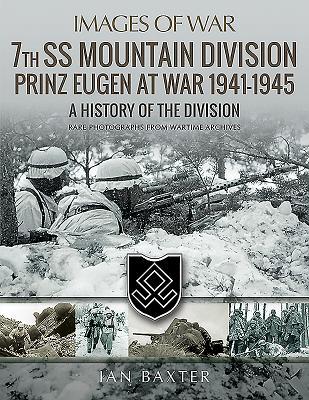Drawing on a superb collection of rare and unpublished photographs the The 7th SS Volunteer Mountain Division Prinz Eugen 1941 – 1945 is the 7th book in the Waffen-SS Images of War Series written by Ian Baxter. The book tells the story of the 7th SS Mountain Division was formed in 1941 from the Volksdeutsche (ethnic German) volunteers and conscripts from the Banat, Independent State of Croatia, Hungary and Romania. It fought a brutal counter insurgency campaign against communist-led Yugoslav Partisan resistance forces in the occupied Serbia and Montenegro. It was given the title Prinz Eugen after Prince Eugene of Savoy, an outstanding military leader of the Habsburg Empire who liberated the Banat and Belgrade from the Ottoman Empire in the Austro Turkish War. It was initially named the SS-Freiwilligen-Division Prinz Eugen (SS-Volunteer Division Prinz Eugen).
GUEST REVIEW FROM MARK MAGUIRE
Today I am delighted to be able to hand over my blog to my husband Mark so he can share with you his review for Images of War – 7th SS Mountain Division Prinz Eugen at War 1941-1945: A History of the Division!
“This book forms part of the successful “Images of War” series. I own a number of these publications and I consider them to be invaluable when conducting preliminary research into a ‘new’, and /or specialist element of the broader Second World War narrative.
The book follows the traditional structure synonymous with the series. The contents of this particular book are broken down as follows: Formation; Anti -Partisan operations, Operation Weiss, Guerrilla Warfare, Last Months and the Order of Battle. The author provides a brief, but informative treatment of the subject at hand which is then accompanied by a selection of photographs accompanied by captions of varying length and intensity.
In this work, Ian Baxter considers the history of the 7th SS Mountain Division Prinz Eugen and its campaign against partisans in Yugoslavia, which, in itself was a corollary of the broader German offensive against Greece. The division itself was unique in that it conscripted from the Banat, an independent state of Croatia; Hungary and Romania, representing a substantial shift from the strict criterion which underpinned its counterparts in other theatres.
The divisions’ raison d’etre was to combat “the Chetniks”, Yugoslav partisans who launched a brutal and tenacious Guerilla campaign against the invading force, the brutality of which was met with indiscriminate killings and innumerable atrocities on the part of the SS for which it has become synonymous. Victory for either side would perhaps be best described as being pyrrhic.
The book could have been quite dark given the subject matter, however, the right balance is struck between an informative, but brief narrative, combined with photographs of varying poignancy. The net result is a book which addresses the barbarism of the campaign whilst positing it against the geo-political and tactical exigencies of the theatre. In light of this, the book, along with its fellow Images of War counterparts could either be read as a standalone quick read for the curious or as a foundation for further readings in this field.”

